 W
WThe cuisine of Mauritius is influenced by the tropical location of the island as well as the cultural diversity which characterizes the country. Mauritian cuisine is a blend of African, Chinese, European and Indian influences in the history of Mauritius. Local food varies depending on ethnic communities; this reflects the strong traditional, cultural, and historical influences of each community. Dishes from French cuisine have grown very popular in Mauritius. Most of the dishes and practices into the culinary traditions are inspired by French culture, former African slaves, and Indian workers and Chinese migrants arriving during the 19th century.
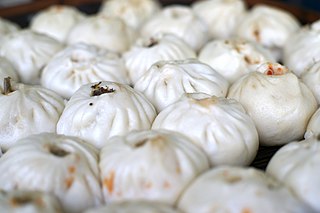 W
WBaozi, or bao, is a type of yeast-leavened filled bun in various Chinese cuisines. There are many variations in fillings and preparations, though the buns are most often steamed. They are a variation of mantou from Northern China.
 W
WBiryani is a mixed rice dish originating among the Muslims of the Indian subcontinent. It is made with Indian spices, rice, and meat usually that of chicken, goat, lamb, prawn, fish, and sometimes, in addition, eggs or vegetables such as potatoes in certain regional varieties.
 W
WChar siu bao is a Cantonese barbecue-pork-filled bun (baozi). The buns are filled with barbecue-flavored cha siu pork. They are served as a type of dim sum during yum cha and are sometimes sold in Chinese bakeries. Cha siu refers to the pork filling; the word bao means "bun".
 W
WChapati, also known as roti, rotli, safati, shabaati, phulka and roshi, is an unleavened flatbread originating from the Indian subcontinent and staple in India, Nepal, Bangladesh, Pakistan, Sri Lanka, East Africa, Arabian Peninsula and the Caribbean. Chapatis are made of whole-wheat flour known as atta, mixed into dough with water, oil and optional salt in a mixing utensil called a parat, and are cooked on a tava.
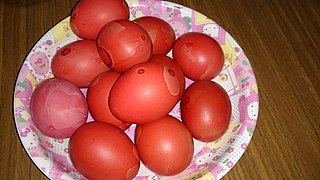 W
WChinese red eggs are bright pink coloured cooked chicken eggs. The eggs are first hard boiled before a wet red calligraphy paper is wiped over the eggs to create a pink coloring.
 W
WDaube is a classic Provençal stew made with inexpensive beef braised in wine, vegetables, garlic, and herbes de Provence, and traditionally cooked in a daubière, a braising pan. A traditional daubière is a terracotta pot that resembles a pitcher, with a concave lid. Water is poured on the lid, which condenses the moisture inside, allowing for the long cooking required to tenderize lesser cuts of meat. The meat used in daube is cut from the shoulder and back of the bull, though some suggest they should be made from three cuts of meat: the "gelatinous shin for body, short ribs for flavor, and chuck for firmness." Although most modern recipes call for red wine, a minority call for white, as do the earliest recorded daube recipes.
 W
WFa gao, also called Fat pan by the Hakka, prosperity cake, Fortune cake, Cantonese sponge cake, is a Chinese steamed, cupcake-like pastry. Because it is often characterized by a split top when cooked, it is often referred as Chinese smiling steamed cake or blooming flowers. It is commonly consumed on the Chinese new year. It is also eaten on other festivals, wedding, and funerals by the Hakka people.
 W
WA falooda is an Indian version of a cold dessert made with noodles. It has origins in the Persian dish faloodeh, variants of which are found across West, Central, and South Asia. Traditionally it is made by mixing rose syrup, vermicelli, and sweet basil seeds with milk, often served with ice cream. The vermicelli used for preparing falooda is made from wheat, arrowroot, cornstarch, or sago.
 W
WFish balls are rounded meat balls made from fish paste which are then boiled or deep fried. Similar in composition to fishcake, fish balls are often made from fish mince or surimi, salt, and a culinary binder such as tapioca flour, corn, or potato starch.
 W
WFried rice is a dish of cooked rice that has been stir-fried in a wok or a frying pan and is usually mixed with other ingredients such as eggs, vegetables, seafood, or meat. It is often eaten by itself or as an accompaniment to another dish. Fried rice is a popular component of East Asian, Southeast Asian and certain South Asian cuisines, as well as a staple national dish of Indonesia and Malaysia. As a homemade dish, fried rice is typically made with ingredients left over from other dishes, leading to countless variations. Fried rice first developed during the Sui Dynasty in China and as such all fried rice dishes can trace their origins to Chinese fried rice.
 W
WGrass jelly, or leaf jelly or herb jelly, is a jelly-like dessert eaten in East and Southeast Asia. It is created by using the Platostoma palustre plant and has a mild, slightly bitter taste. It is served chilled, with other toppings such as fruit, or in bubble tea or other drinks. Outside Asia, it is sold in Asian supermarkets.
 W
WGulab jamun is a milk-solid-based sweet, originating in India and a type of mithai popular in India, Nepal, Pakistan, the Maldives, and Bangladesh, as well as Myanmar. It is also declared as the national dessert of Pakistan officially by Government of Pakistan. It is also common in nations with substantial populations of people with South Asian heritage, such as Mauritius, Fiji, the Malay Peninsula, Great Britain, South Africa, and the Caribbean countries of Jamaica, Trinidad and Tobago, Guyana, and Suriname. It is made mainly from milk solids, traditionally from khoya, which is milk reduced to the consistency of a soft dough. Modern recipes call for dried or powdered milk instead of khoya. It is often garnished with dried nuts such as almonds and cashews to enhance flavour. Started by Gits Food in 2020, World Gulab Jamun Day is celebrated on 10th October every year.
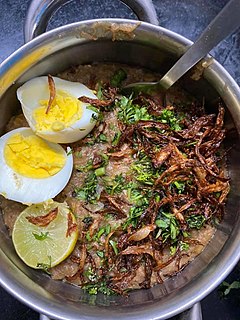 W
WHaleem is a type of stew popular in the Middle East, Central Asia, the Indian subcontinent. Although the dish varies from region to region, it optionally includes wheat or barley, meat and lentils. Popular variations include keşkek in Turkey, Iran, Afghanistan, Tajikistan, Uzbekistan, Azerbaijan and northern Iraq; hareesa in the Arab world and Armenia; Halim in Bangladesh and West Bengal, India; khichra in Pakistan and India.
 W
WJalebi, also known as jilapi, jilebi, jilipi, zulbia, jerry, mushabak, or zalabia, is a popular Indian sweet snack. It is made by deep-frying maida flour batter in pretzel or circular shapes, which are then soaked in sugar syrup.
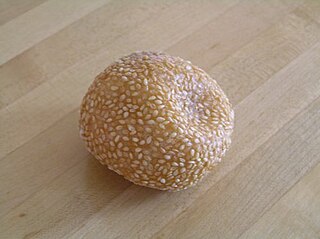 W
WJiandui is a type of fried Chinese pastry made from glutinous rice flour. The pastry is coated with sesame seeds on the outside and is crisp and chewy. Inside the pastry is a large hollow, caused by the expansion of the dough. The hollow of the pastry is filled with a filling usually consisting of lotus paste, or alternatively sweet black bean paste, or red bean paste. They are also sometimes referred to as sesame balls.
 W
WA lamington is an Australian cake made from squares of butter cake or sponge cake coated in an outer layer of chocolate sauce and rolled in desiccated coconut. The thin mixture is absorbed into the outside of the sponge cake and left to set, giving the cake a distinctive texture. A common variation has a layer of cream or strawberry jam between two lamington halves.
 W
WA mooncake is a Chinese bakery product traditionally eaten during the Mid-Autumn Festival (中秋節). The festival is about lunar appreciation and Moon watching, and mooncakes are regarded as a delicacy. Mooncakes are offered between friends or on family gatherings while celebrating the festival. The Mid-Autumn Festival is widely regarded as one of the four most important Chinese festivals.
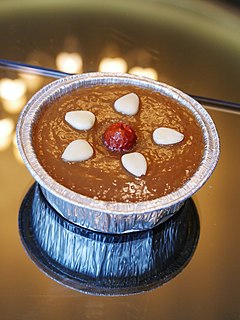 W
WNian gao, sometimes translated as year cake or New Year cake or Chinese New Year's cake, is a food prepared from glutinous rice flour and consumed in Chinese cuisine. It is also simply known as "rice cake". While it can be eaten all year round, traditionally it is most popular during the Chinese New Year. It is considered good luck to eat nian gao (年糕) during this time of the year because nian gao (年糕) is a homonym for "higher year" or "grow every year" (年高), which means "a more prosperous year". The character 年 is literally translated as "year", and the character 糕 (gāo) is literally translated as "cake" and is identical in sound to the character 高, meaning "tall" or "high". Nian gao (年糕) also has the exact homonym for "sticky cake" (粘糕); the character 粘 (nián), meaning "sticky".
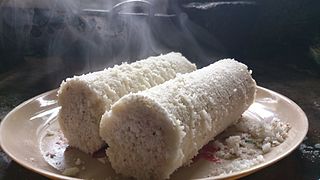 W
WPuttu is a breakfast dish eaten in the South Indian states of Kerala, Tamil Nadu and parts of Karnataka, as well as Sri Lanka. Puttu means "portioned" in Tamil and Malayalam. It is made of steamed cylinders of ground rice layered with coconut shavings, sometimes with a sweet or savory filling on the inside. Puttu is served hot with sweet side dishes such as palm sugar or banana, or with curries including dal, chickpea, mutton, fish, chicken, or beef curry.
 W
WRasgulla, also known as Rosogolla, Rosgola, or Rasagola is a South Asian syrupy dessert popular in the Indian subcontinent and regions with South Asian diaspora. It is made from ball-shaped dumplings of chhena and semolina dough, cooked in light sugar syrup made of sugar. This is done until the syrup permeates the dumplings.
 W
WRoti is a round flatbread native to the Indian subcontinent made from stoneground whole wheat flour, traditionally known as gehu ka atta, and water that is combined into a dough. Roti is consumed in many countries worldwide. Its defining characteristic is that it is unleavened. Naan from the Indian subcontinent, by contrast, is a yeast-leavened bread, as is kulcha. Like breads around the world, roti is a staple accompaniment to other foods.
 W
WSachima is a sweet snack in Chinese cuisine made of fluffy strands of fried batter bound together with a stiff sugar syrup, somewhat similar to American Rice Krispies Treats. It originated in Manchuria and is now popular throughout China and Taiwan. Its decoration and flavor vary in different regional Chinese cuisines, but the appearance of all versions is essentially the same.
 W
WA soy egg is a type of egg in Chinese cuisine, Japanese cuisine, and Mauritian cuisine which is boiled, peeled, and then cooked in a mixture of soy sauce, sugar, water, and other optional herbs and spices. Other ingredients such as meat, vegetables and tofu can be cooked in the same red cooking method, resulting in dishes generally referred to as lou mei. Soy eggs can be made from chicken, duck, and quail eggs.
 W
WThali or Bhojanam is a round platter used to serve food in South Asia and Southeast Asia. Thali is also used to refer to an Indian-style meal made up of a selection of various dishes which are served on a platter.
 W
WZongzi or simply zong is a traditional Chinese rice dish made of glutinous rice stuffed with different fillings and wrapped in bamboo leaves, or sometimes with reed or other large flat leaves. They are cooked by steaming or boiling. In the Western world, they are also known as rice dumplings or sticky rice dumplings.